
WHEN looking for appropriate material for Memorial Day weekend my thoughts turned to Myrtle Avenue, a lengthy street that is about equal parts in Brooklyn and Queens, and I remembered the numerous war memorials found on Myrtle between downtown Brooklyn and its east end in Jamaica. I last walked the entire road in installments between 2010 and 2011, so if you’re new to FNY, you don’t remember my pages describing that walk which begin here. I hope you will indulge me this weekend as I’ll repeat those war memorials’ descriptions from that series here.
Myrtle Avenue, named for native trees (as was Linden Boulevard) was first laid out in 1835 from Fulton Street as far as Cripplebush Road, an ancient Kings County track now largely replaced by Bedford Avenue. It was extended in 1839 to Brooklyn’s Broadway, and again in 1854 as the tolled Jamaica Plank Road out to Jamaica. (Most of NYC’s toll roads of this type were made “free” around 1890-1900.) Horsecars appeared on Myrtle in 1854, which later became trolleys taking electric power from overhead wires. The infamous El shrouded Myrtle from 1888 to 1969 — at first as far as Grand Avenue, to Brooklyn’s Broadway early in 1889, and to Wyckoff Avenue later the same year. The structure reached its current terminal, Metropolitan Avenue as a surface line and it was “ellified” in the 1910s. Meanwhile, the western end of Myrtle Avenue between Fulton and Jay was eliminated for courthouse construction and Cadman Plaza in the 1950s, while the stretch between Jay and Flatbush Avenue Extension became part of MetroTech Center beginning in 1989.
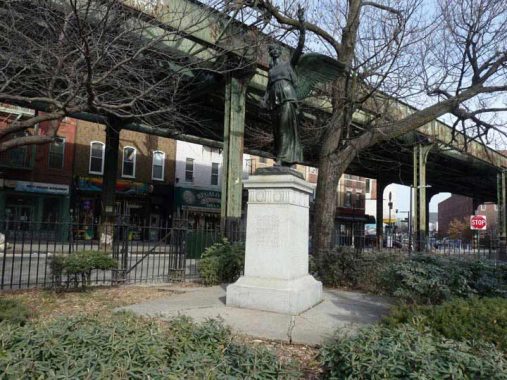
The first of the Myrtle Memorials is found in Bushwick, at Willoughby and Bushwick Avenues. The triangle across from the Ulmer/Cook mansion, Freedom Triangle, contains the first of two war memorials along Myrtle Avenue alongside the el structure. Both are works of sculptor Pietro Montana. The “Angel of Victory With Peace” was installed here in 1921 and honors Bushwick’s 93 casualties in World War I.

She appears to us to be wearing the crown of Victory, sword hilt forward and face transfigured. Her arm uplifted in a torch-like gesture to the vision of peace — the supposed end for which the Great War was fought, by America at least. The ninety-three dead who were sacrificed to it are carved on the handsome pedestal. Both statue and setting have been recently restored, thanks to the Department of Parks Division of Art and Antiques, and Greenstreets. — Cal Snyder in Out of Fire and Valor
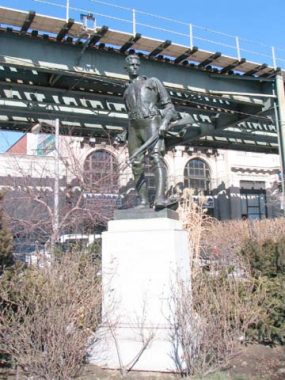
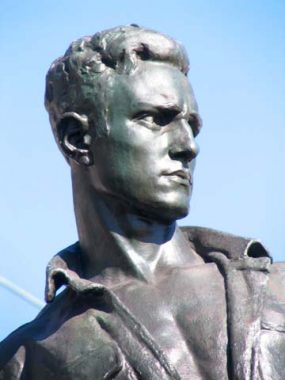
At Heisser Triangle, Knickerbocker and Myrtle Avenues and Bleecker Street, is the second war memorial found along this stretch of Myrtle. The triangle is named for a World War I sergeant in the Headquarters Company, 106th Infantry, who perished in France during WWI. Sgt. Heisser lived on nearby Grove Street. The memorial is a second work by sculptor Pietro Montana.
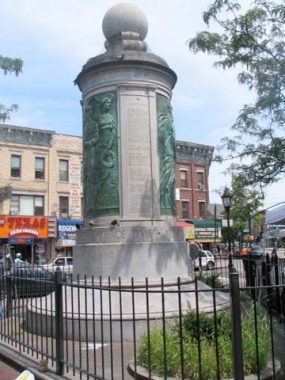
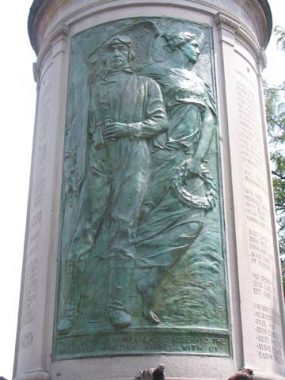
Yet another World War I memorial, the Ridgewood Tholos, or Ridgewood Remembrance, at Cypress and Myrtle, the second intersection in the neighborhood where both streets’ second letter is “y.” (Wyckoff Avenue was the first).
The finest war memorial in Queens, and one of two or three in the city of surpassing integrity and beauty… the drum-like temple is faced with large, curving bronze panels that work together as a narrative, depicting the three theatres of war, the men who fought there, and the angels who guided and walked beside them. The bronze workmanship is superb, lending the figures drama, unique personalities, and scenes that are filled with interest. Alternating with the panels are granite fascias that list the names of dead.
…[T]his memorial not only has superb bronze workmanship but exalted speech that gives it a genuine greatness, casting the figures into a light of acute longing, love and sacrifice. The words speak from the bands of bronze beneath the figures, and are also graven into a continuous frieze around the base of the panels: “They upheld America’s cause, and the hallowed memory abides with us.” And: “I am summoned by my country, whose voice I can never hear without veneration and love.” And, in the granite it is written: ” They earned eternity in a brief moment of time.” — Cal Snyder, Out of Fire and Valor
The architects were Hemle and Corbett, the sculptor Anton Schaaf. It was dedicated on Memorial Day, 1923.
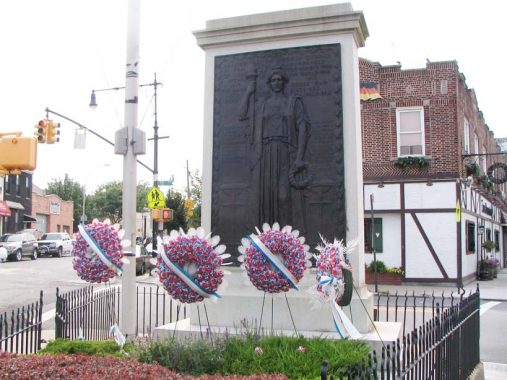
At Cooper Avenue, we see Myrtle Avenue’s 4th war memorial at Glendale Veterans Triangle. Pietro Montana sculpted war memorials at Bushwick and Knickerbocker Avenues in Bushwick, and Anton Schaaf created this handsome view of Lady Liberty facing east, toward the battlefields of Europe, in the triangle formed by Cooper and Myrtle Avenues and 70th Street across the street from Zum Stammtisch. Schaaf also shaped Ridgewood’s memorial at St. Nicholas Avenue, called by Cal Snyder in Out of Fire and Valor the finest war memorial in Queens. 21 Glendale residents, named on the bronze, are remembered here.
The north side of Myrtle Avenue and Park Lane South features Myrtle’s 5th war memorial, The Doughboy, popularly called the My Buddy memorial. It was installed in 1926 and was sculpted by Joseph Pollia, who later designed the General Philip Sheridan memorial in Greenwich Village’s Sheridan Square at 7th Avenue South and Christopher Street. It depicts a World War I soldier pausing by the grave of a fallen colleague. 71 names of fallen Richmond Hill residents are on the nameplate.
Joseph E. Schaefer (1918-1987) was a resident of Richmond Hill who distinguished himself in World War II for having repelled, almost single-handedly, a Nazi attack on American troops positioned near Stolberg, Germany. Schaefer, who served as Staff Sergeant to Company I, 18th Infantry, United States Army, received the Congressional Medal of Honor in 1945 for his defensive actions. The commendation by President Harry S. Truman inscribed on one side of the monument is taken from Schaefer’s Medal of Honor citation.
The Schaefer Oval was dedicated on March 24, 1987, shortly after Sgt. Schaefer passed away. Landscape Architect Signe Neilsen designed the octagonal granite outcropping that features inscriptions commemorating Schaefer’s service and a representation of the Medal of Honor, as well as the plantings in the oval. NYC Parks
As always, “comment…as you see fit.” I earn a small payment when you click on any ad on the site.
5/28/23

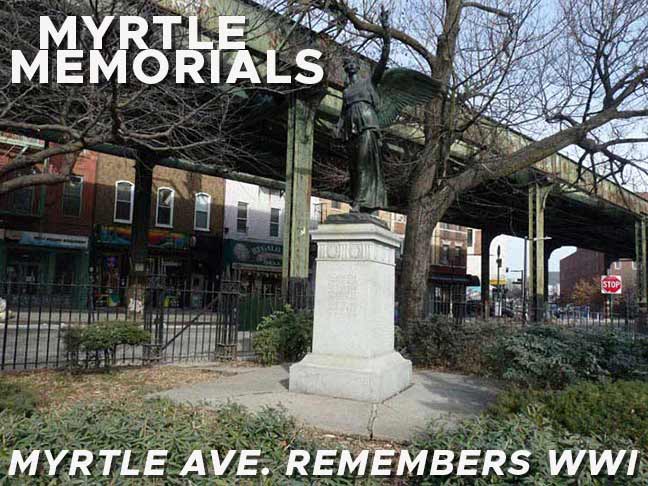
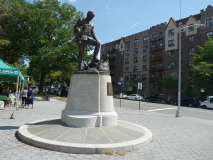


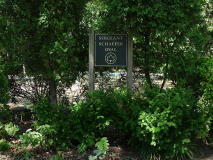
5 comments
Myrtle Ave. was also an abandoned station on the BMT Line, just before the train ascended to the Manhattan Bridge. I think now they’ve destroyed all traces of the above-ground portion of that station.
Wonder if Sgt. Heisser actually looked like the statue or did they use a model? Either way, that is one handsome man. That jawline!
May I add a few more historical details about the history of the Myrtle Avenue Elevated?
As noted the original elevated, then steam-powered, was atop Myrtle Avenue beginning in 1888. Around the turn of the 20th century, a dozen years later – two important events occurred. The Myrtle and its sister Brooklyn Rapid Transit (BRT) el routes were converted to electric power and extended over the Brooklyn Bridge into a new Manhattan terminal, located approximately where #1 Police Plaza now stands. BRT trolley routes on the bridge were also terminated. In 1944 the train tracks were removed from the Brooklyn Bridge, forcing the Myrtle El to terminate at Bridge-Jay Street and requiring riders to use a paper transfer to cross the bridge on a trolley car. The bridge trolleys, in turn, stopped in 1950 and afterward Myrtle El riders used a paper transfer to access the IND subway at Jay Street-Borough Hall in order to reach Manhattan.
In October 1969 the Myrtle El stopped running south of Broadway, Brooklyn. The structure north of Broadway is still in use, part of today’s M train route. If you stand on the east end of the M and J.Z train platform at Broadway-Myrtle Ave., you will see the last remaining flat junction on the NYC subways, meaning that trains that operate in opposing directions must cross each other, obviously protected by signals.
I meant to say, “BRT trolley routes on the bridge were also terminated at that new terminal.” Sorry
Flushing has the Flushing Greens, located on Northern Boulevard by Main Street, that has several beautiful War Memorials, including the great Civil War obelisk
erected in 1865.
https://www.nycgovparks.org/parks/flushing-greens/monuments/page/1